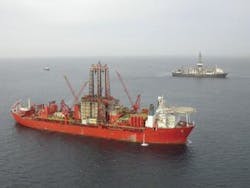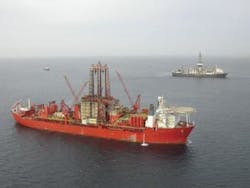Smedvig keen to transfer semi tender drilling concept to West Africa
Nick Terdre
Contributing Editor
Drilling contractor Smedvig has returned to the West African market with a bang. It currently has three contracts and is well positioned to seek further work in the region. CEO Kjell E Jacobsen is pleased to be back. West Africa is the market in which he expects to see the most significant growth next year in both exploration and production.
After being absent from West Africa since the late 1990s, Smedvig made its way back last year through a two-well exploration contract off Mauritania with Woodside Petroleum. The work was carried out by drillship West Navigator, which demonstrated its capabilities when drilling the Tiof West well on the Chinguetti field. From arrival on location to completion of drilling at a total depth of 2,992m, the rig first set and tested the BOP in a water depth of 1,351 m, and then drilled 1,641 m, all in a record-breaking 5.3 days.
West Navigator is equipped with a dual derrick which allows drilling and completion operations to be performed simultaneously, enabling it to achieve a 20-40% gain in efficiency compared with single-derrick units, the company says. The rig, designed for working in both deep waters and harsh environments, has a high deck-load capacity which enables it to carry up to 2,500 m of riser and 10,000 m of drill-pipe, giving it a high degree of autonomy.
The ship's impressive performance on Tiof West prompted Woodside to negotiate the ensuing development drilling assignment with Smedvig on a single-source basis, resulting in a one-year contract. It is due to return to Chinguetti in August, after completing one deepwater exploration well each for Amerada Hess and ChevronTexaco west of the Shetlands. Since it came into operation in 2000, West Navigator has drilled the majority of deepwater wells this side of the Atlantic, Jacobsen points out.
It is likely to maintain this status for some time, as its next assignment after Chinguetti will be to drill the Ormen Lange development wells in the Norwegian sector for Shell. This involves eight firm wells in a water depth of around 900 m, plus four options. The firm part of the contract, which is expected to take 740 days, is worth $167 million.
Elsewhere in West Africa, Smedvig has two rigs drilling development wells for Total in the Congolese sector. West Menang, a semisubmersible tender rig, and T-8, a conventional monohull barge, both began work in June on the N'Kossa field. West Menang is drilling demanding extended-reach wells beyond the capacity of the local tender rig fleet, while T-8, which has proved its capabilities during previous assignments for Total in Thailand, is drilling in-field wells.
Smedvig is the leading tender rig operator, managing 10 of the worldwide fleet of 21 units. But Jacobsen attributes the company's success in winning the contracts in large part to a continuing program of investment in upgrading and expanding the fleet, dating back to the late 1990s. It has just replaced the 1975-built T-2 with T-9, which was delivered earlier this year.
While the traditional tender rig is a monohull barge intended for operation in benign weather conditions, Smedvig has focused on developing the semisubmersible tender rig concept. West Pelaut, built in 1994, underwent a significant upgrade this year, while three new rigs have been or are being built. West Menang was delivered in 1999 and West Alliance in 2001. This year an order has been placed with the Keppel FELS yard in Singapore, which built the company's previous three semi tenders, for the construction of West Setia – delivery is due in the third quarter of 2005.
The new unit has been designed with a larger air gap than the existing units. This will give it better marine characteristics, allowing it to operate in parts of the Pacific Asia region where climatic conditions are tougher, such as Cambodia, Vietnam and western Australia, and in the deepwater provinces of Brazil, Gulf of Mexico and West Africa.
null
The semi-tender can offer significant benefits for deepwater developments, Jacobsen says. They enable fields to be developed with a mini floating dry-tree platform such as a tension-leg platform (TLP) or spar. The semi tender imposes a design load on the platform only one quarter that of a platform rig, and has a deck area requirement of less than a quarter. The size and displacement of the platform, and its costs, are thus significantly reduced. The company already has one rig deployed on such an assignment – this is West Alliance, which is drilling wells for Unocal at the West Seno TLP in the Indonesian sector.
Jacobsen sees no reason why Smedvig's semi tender rigs should not take on deepwater drilling assignments in West Africa. "The system is working well at West Seno," he says. "We believe this is a very promising and cost-effective concept, and see significant growth potential for it.
"We're keen to introduce the concept into West Africa, and we've been talking to operators there. We know it takes time to introduce a new concept, and we have to be patient and persistent. But the West Seno operation allows us to demonstrate how it works in practice."
The company's efforts may be helped if, as Jacobsen believes, the offshore sector is now in the early stages of an up-cycle. "To meet growing oil and gas demand, our customers will have to increase their spending on exploration and development," he says. "The fact that most forecasters see oil prices remaining relatively high should support such a move." In this case, against a background of strengthening rig demand, the semi tender's attractions in deepwater development drilling could be accentuated.
At the same time a renewed interest in frontier exploration drilling would also benefit Smedvig, one of the few players with modern deep-water, harsh-environment units. In addition to West Navigator, it has the fifth generation semi West Venture, also equipped with a dual derrick.

